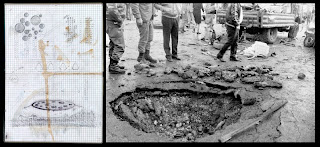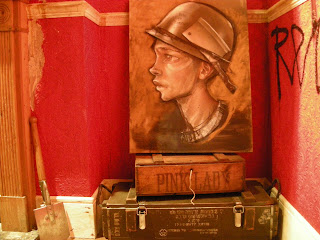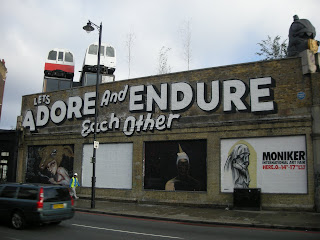Wally Raad: Miraculous Beginnings
14th October 2010 - 2 January 2011
The Atlas Group archive is a collective artwork over a period between 1989-2004 with particular emphasis on the Lebanese wars. This group of archives is divided into 3 categories: A - authored files, FD - found files and AGP - Atlas Group Productions. A range of medium such as photographs, videos, and collages are used in the creation of this particular archive.
The exhibitions opens with an AGP (Atlas Group itself) project ‘My neck is thinner than a hair’.
It focuses on car engines found after car bombings during the Lebanese wars from 1975 to 1998. The series of black and white photographs document the situation. The images, either in close-up or of empty landscapes often include gatherings of curious individuals. Some of the engines are still steaming, which attract even more attention amongst locals. The scenarios appear to be public events, especially with a marital presence. Moving from one photograph to another, the location looks rough and shabby, even dangerous.
Another AGP series includes the work of topographer Nahia Hassan. His pictures of fiery steam have been displayed on white paper, giving an impact on its own. The miniature patterns of steam are photographed in various stages, from warm yellow to radiant orange.
Before moving on, a video footage from group A files pauses the audience to watch a tape of an Arab hostage Bachar. His captivity compared to that of five Americans hostages, was the longest. During his time in the cell he received disgust and mixed feelings from fellow inmates that would turn him on. His cellmates, the five Americans all wrote a book about their hostage years in Lebanon which was published in five different versions. Bachar shared his story with The Atlas Group project.
A collection of group A introduces a series of notebooks by a fictional character a man the name of, Dr. Fakhouri. His first collage type project called ‘Already been in a lake of fire’ draws attention to cutout photographs of cars. Models ranging from U.S Volvo to Chevrolet in shaded blue and plum colour. The details, in Arabic include the relevant information as to how many people each car bomb killed or injured. It reflects a study based on car bombings.
The following project ‘Civilizationally we do not only dig holes to bury ourselves’ is based on a series of black and white self-portraits documenting Dr. Fakhouri’s journeys to Paris, Rome and Lebanon. Mostly he has been photographed alone in front of tourist sites. His sense of belonging is expressed when he posed with strangers.
Another series titled ‘Missing Lebanese Wars’ draws attention to Dr. Fakhouri’s obsession with gambling at horse racing. A description of equine records and several other notes have been included on a collage type artwork.
A series of large photographs of air and sea assault over West Beirut cover a whole wall. The photos illustrate the bombings and the soldiers on a break. The series from type A file is titled “We decided to let them say ‘we are convinced’ twice”. At the time Wally Raad, a young teenager was trying to capture the true action. The sensation captured on film is incredible, inflamed steam, curiosity in people eyes, and relaxing soldiers.
One of the most vivid projects in type A collection is ‘Let’s be honest the weather helped.’ Like many others at the time in Beirut Wally Raad also collected bullets and shrapnel. In photographs of bombed, even demolished houses, all the bullet holes have been pasted-up with correctly measured dots. Raad marked different ammunition with a distinctive colour code. The photographs portray an empty city, with no-one in the streets. The only colour in the abandoned place got is from the pasted-up bullet holes in yellow, green, orange and purple.
The remarkable collection in catalog FD titled ‘Secrets in the open sea’ contains a series of photographs in shades of blue that were found buried under the rubble during 1992. Currently below the blue shades are depicted small pictures of people who died. The recovered photographs were once prints of individuals before a demolition of Beirut’s commercial district. The cuts into plain paper subtly expose the human figures, the dead, beneath it.
In between the dramatic war scenes and recovery time is a collection of abstract Arabic art. A series of details from artists such as Neon Saadi, Johnny Tahan, Zohrab and an architect in Lebanon is displayed in collage form. Each collage includes artist sketches, reviews, accounts and even price lists. Contemporary Arabic art emerged from various forms and colours, while the wars affected also layers and lines.
Recovery time includes panoramas taken of Beirut while it was re-built during 1996-1997. The photographs stitched and overlapping expose beautiful shades of sky, from morning to sunset. In the series are shots of contemporary Beirut buildings, still shabby, and portraits of people.
‘Sweet talk’ is in the collection of AGP Group photographs taken in the late 1980s. In the midst of the Lebanese wars, Wally Raad committed himself to capturing Beirut residents, street scenes, and objects in order to document the everyday life.
Photographs from
http://www.theatlasgroup.org/





















































